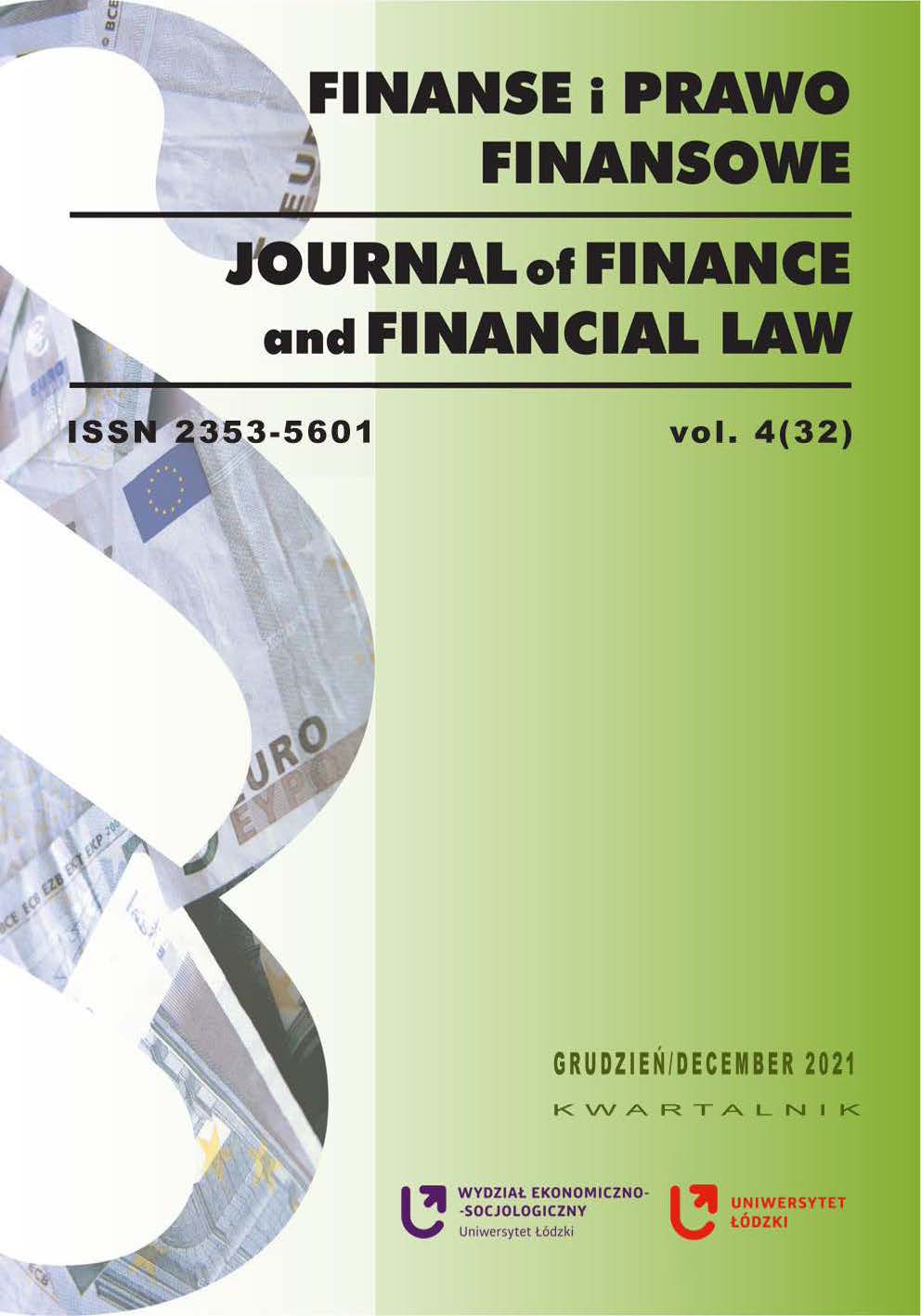Change Dynamics of Electricity Prices for Households in the European Union between 2011 and 2020
DOI:
https://doi.org/10.18778/2391-6478.4.32.07Keywords:
electricity price, energy sector, sustainable developmentAbstract
The aim of the article: The aim of the article is to evaluate and analyze the dynamics of electricity prices for households in the European Union member states (EU-27) in the period 2011–2020. The study also focuses on the key components of electricity prices in the countries analyzed. The discussed issues are important from the socio-economic point of view. It refers to the issue of sustainable development, where electricity prices are addressed in relation to the problem of energy poverty of households.
Methodology: The study is of a theoretical and analytical character. In addition to the review of available dnational and foreign literature, Eurostat data on electricity prices for households in the EU-27 were analysed. Moreover, the paper presents the application of a selected cluster analysis method, i.e. the k-means method, to assess the situation of the EU-27 countries in terms of electricity prices for households in the analysed period of 2011–2020.
Results of the research: The result of the analyses undertaken is a presentation of the share of VAT and other taxes and levies in the price of electricity for households. The analyses showed differences between the countries in the structure of establishing the electricity price for households. Only in three countries (Bulgaria, Hungary, Slovakia) it was found that there was no share of other taxes and levies in the electricity price. In turn, the applied k-means method contributed to obtaining the division of countries into four groups reflecting the differentiation in terms of the amount of electricity price for households in the period under study.
Downloads
References
Ansari, D. and Holz, F. (2020). Between stranded assets and green transformation: Fossil-fuel-producing developing countries towards 2055. World Development, 130, 104947.
Google Scholar
DOI: https://doi.org/10.1016/j.worlddev.2020.104947
Anton, S.G. and Nucu, A.E.A. (2020). The effect of financial development on renewable energy consumption. A panel data approach. Renewable Energy, 147, pp. 330–338.
Google Scholar
DOI: https://doi.org/10.1016/j.renene.2019.09.005
Benthaus, M. (2019). A coupled technological-sociological model for national electrical energy supply systems including sustainability. Energy, Sustainability and Society, 9(1), pp. 1–16.
Google Scholar
DOI: https://doi.org/10.1186/s13705-019-0221-4
Crespi, F. (2016). Policy complexity and the green transformation of the economies as an emergent system property. Environmental economics and policy studies, 18(2), pp. 143–157.
Google Scholar
DOI: https://doi.org/10.1007/s10018-015-0131-4
Eurostat, https://ec.europa.eu/eurostat/databrowser/view/nrg_pc_204/default/table?lang=en [Accessed: 23.08.2021].
Google Scholar
Gasparatos, A., Doll, C.N., Esteban, M., Ahmed, A. and Olang, T.A. (2017). Renewable energy and biodiversity: Implications for transitioning to a Green Economy. Renewable and Sustainable Energy Reviews, 70, pp. 161–184.
Google Scholar
DOI: https://doi.org/10.1016/j.rser.2016.08.030
Gatnar, E. and Walesiak, M. (2004). Metody statystycznej analizy wielowymiarowej w badaniach marketingowych. Wrocław: Wydawnictwo Akademii Ekonomicznej.
Google Scholar
Hartigan, J.A. and Wong, M.A. (1979). Algorithm AS 136: A K-Means Clustering Algorithm. Journal of the Royal Statistical Society, 28(1), pp. 100–108.
Google Scholar
DOI: https://doi.org/10.2307/2346830
Heffner, K. and Gibas, P. (2007). Analiza ekonomiczno-przestrzenna. Katowice: Wydawnictwo Akademii Ekonomicznej.
Google Scholar
Herrero, S.T. (2017). Energy poverty indicators: A critical review of methods, Indoor and Built Environment, 26(7), pp. 1018–1031.
Google Scholar
DOI: https://doi.org/10.1177/1420326X17718054
Lai, H. and Warner, M. 2(015). Transformation of China's energy sector: trends and challenges. Asia Pacific Business Review, 21(1), pp. 147–153.
Google Scholar
DOI: https://doi.org/10.1080/13602381.2014.939900
Li, J., Zhang, X., Ali, S. and Khan, Z. (2020). Eco-innovation and energy productivity: New determinants of renewable energy consumption. Journal of Environmental Management, 271, 111028.
Google Scholar
DOI: https://doi.org/10.1016/j.jenvman.2020.111028
Llera-Sastresa, E., Scarpellini, S., Rivera-Torres, P., Aranda, J., Zabalza-Bribián, I. and Aranda-Usón, A. (2017). Energy vulnerability composite index in social housing, from a household energy poverty perspective. Sustainability, 9(5), p. 691.
Google Scholar
DOI: https://doi.org/10.3390/su9050691
MacQueen, J. (1967). Some Methods for Classification and Analysis of Multivariate Observations. In Proceedings of the Fifth Berkeley Symposium on Mathematical Statistics and Probability, Volume 1: Statistics, 281–97. Berkeley, Calif.: University of California Press.
Google Scholar
Omer, A.M. (2017). Sustainable development and environmentally friendly energy systems. International Journal of Physical Sciences and Engineering, 1(1), pp. 1–39.
Google Scholar
DOI: https://doi.org/10.21744/ijpse.v1i1.2
Østergaard, P.A., Johannsen, R.M. and Duic, N. (2020). Sustainable development using renewable energy systems. International Journal of Sustainable Energy Planning and Management, 29, pp. 1–6.
Google Scholar
Panek, T. (2009). Statystyczne metody wielowymiarowej analizy porównawczej. Warszawa: Oficyna Wydawnicza SGH.
Google Scholar
Primc, K. and Slabe-Erker, R. (2020). Social policy or energy policy? Time to reconsider energy poverty policies. Energy for Sustainable Development, 55, pp. 32–36.
Google Scholar
DOI: https://doi.org/10.1016/j.esd.2020.01.001
Pultowicz, A. (2009). Przesłanki rozwoju rynku odnawialnych źródeł energii w Polsce w świetle idei zrównoważonego rozwoju. Problemy ekorozwoju, 4(1), pp. 109–115.
Google Scholar
Sarkodie, S.A. and Strezov, V. (2019). Effect of foreign direct investments, economic development and energy consumption on greenhouse gas emissions in developing countries. Science of the Total Environment, 646, pp. 862–871.
Google Scholar
DOI: https://doi.org/10.1016/j.scitotenv.2018.07.365
Sulich, A. (2018). Znaczenie koncepcji ekonomii zrównoważonego rozwoju. Rynek–Społeczeństwo – Kultura, 4(30), pp. 24–27.
Google Scholar
Sulich, A. and Grudziński, A. (2019). The analysis of strategy types of the renewable energy sector. Acta Universitatis Agriculturae et Silviculturae Mendelianae Brunensis, 67(6), pp. 1643–1651.
Google Scholar
DOI: https://doi.org/10.11118/actaun201967061643
Świerszcz, K. and Grenda, B. (2018). Poziom ubóstwa energetycznego w wybranych regionach kraju jako miernik poziomu bezpieczeństwa energetycznego w wymiarze społecznym. Przedsiębiorczość i Zarządzanie, 19(2), cz. 3: Bezpieczeństwo zintegrowane współczesnej Polski, pp. 211–230.
Google Scholar
Verbič, M., Filipović, S. and Radovanović, M. (2017). Electricity prices and energy intensity in Europe. Utilities Policy, 47, pp. 58–68.
Google Scholar
DOI: https://doi.org/10.1016/j.jup.2017.07.001
Wang, Q., Su, M., Li, R. and Ponce, P. (2019). The effects of energy prices, urbanization and economic growth on energy consumption per capita in 186 countries. Journal of Cleaner Production, 225, pp. 1017–1032.
Google Scholar
DOI: https://doi.org/10.1016/j.jclepro.2019.04.008
Zalewska, E. (2017). Zastosowanie analizy skupień i metody porządkowania liniowego w ocenie polskiego szkolnictwa wyższego. Prace Naukowe Uniwersytetu Ekonomicznego we Wrocławiu / Research Papers of Wrocław University of Economics, 469, pp. 234–242.
Google Scholar
DOI: https://doi.org/10.15611/pn.2017.469.24
Zhang, Z., and Lis, M. (2020). Modeling green energy development based on sustainable economic growth in China. Sustainability, 12(4), 1368.
Google Scholar
DOI: https://doi.org/10.3390/su12041368
Downloads
Published
How to Cite
Issue
Section
License

This work is licensed under a Creative Commons Attribution-NonCommercial-NoDerivatives 4.0 International License.














